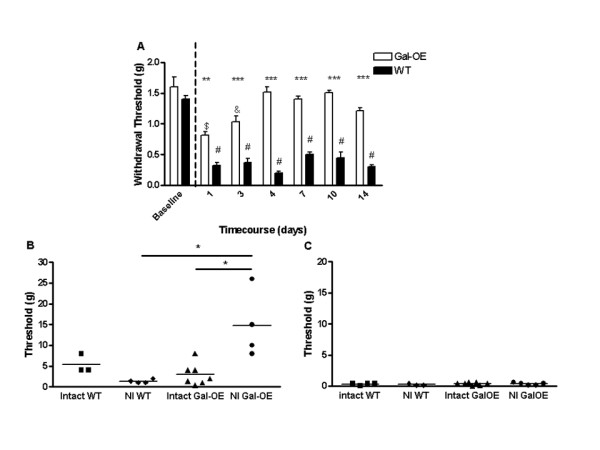Figure 7.

Alterations in mechanical allodynia and primary afferent nociceptor mechanical responses in transgenic galanin over-expressing mice. Transgenic mice that over-express galanin (Gal-OE) recover rapidly from PSNI-induced mechanical allodynia, compared to WT mice. [A] WT and Gal-OE mice have similar baseline mechanical responses before PSNI. Following surgery at day 0 (dotted line), WT mice develop robust mechanical allodynia when compared to baseline values (one way ANOVA with post-hoc Bonferroni multiple comparison test, # p < 0.001, n = 10). Gal-OE mice initially developed mechanical allodynia (one way ANOVA with post-hoc Bonferroni multiple comparison test, day 1 $ p < 0.001, day 3 & p < 0.01, n = 10) but by day 4 mechanical withdrawal thresholds had recovered to baseline values and were significantly different to WT thresholds (two way ANOVA with post-hoc Bonferroni multiple comparison test, ** p < 0.01, *** p < 0.001, n = 10,). [B] Mechanical activation thresholds of nociceptive afferents were significantly increased in the nerve injured (NI day 7) Gal-OE mice compared to uninjured Gal-OE and WT mice (one way ANOVA with post-hoc Bonferroni multiple comparison test, * p < 0.05, Intact WT n = 3, NI WT n = 4, Intact Gal-OE n = 7, NI Gal-OE n = 4). [C] The mechanical activation threshold of mechano-sensitive A fibres were unchanged in the Gal-OE mouse compared to the WT in both intact and PSNI (intact WT n = 4, NI WT n = 3, intact Gal-OE n = 7, NI Gal-OE n = 5).
